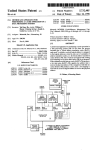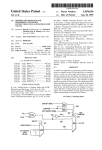Download FUNCTIONAL AMPLIFIER F`VOUT
Transcript
_ US005376819A UllltGd States Patent [19] [11] Patent Number: Gay et al. [45] [54] INTEGRATED CIRCUIT HAVING AN ON CHIP THERMAL CIRCUIT REQUIRING ONLY ONE DEDICATED INTEGRATED CIRCUIT PINAND METHOD OF OPERATION _ Date of Patent: 5,376,819 Dec. 27, 1994 OTHER PUBLICATIONS MC8811O Second Generation RISC Microprocessor User’s Manual, Motorola, Inc., Dec. 1991, pp. l1—6, 11-8, 11-17. [75] Inventors: James G. Gay, P?ugerville; William #- Ledbetter’ Jr” Austm’ both of Fri-man, Examiner__Ngan V_ Ngo Attorney, Agent, or Firm-Robert L. King ex. [73] Assignee: Motorola, Inc., Schaumburg, Ill. [21] Appl NO. 158 323 . .. [22] Filed: Nov. 29, 1993 _ """""""""" " HOIL . .................................. "257/777-338/22 R, . . ABSTRACT An integrated circuit implements an on chip thermal circuit (12) for measuring temperature of an operating integrated circuit die (10) by requiring only one dedi , 5 [57] [58] Field of Search ..................... .. 257/467’, 776, 777338/22 cated integrated circuit pin (16). A second integrated circuit pin (18) is utilized but is also connected directly connected to other circuitry (14) on the integrated cip em‘ and is used by the ether circuitry at the Same time References Cited that the integrated circuit die temperature is being mea sured. In one form, the second integrated circuit pin is a ground terminal. Error voltages coupled to the US. PATENT DOCUMENTS ground terminal may be removed from the temperature [56] 5,140,394 8/1992 Cobb, 111 et a1. ................. .. 257/467 5,l4l,334 8/1992 Castles ... ... ... .. .. .. . . . .. calculatmn by an external ‘ilfferem‘al “Pm-13(24) 257/467 5,230,564 7/1993 Bartilson et a1. .................. .. 257/467 14 Claims, 1 Drawing Sheet V00 DIFFERENTIAL FUNCTIONAL AMPLIFIER F’VOUT OPERATING CIRCUIT 15 GND 1 5,376,819 2 SUMMARY OF THE INVENTION INTEGRATED CIRCUIT HAVING AN ON CHIP THERMAL CIRCUIT REQUIRING ONLY ONE DEDICATED INTEGRATED CIRCUIT PIN AND METHOD OF OPERATION In accordance with one form of the invention, there is provided an integrated circuit having an on chip ther mal circuit requiring only one dedicated integrated circuit pin and a method of implementing a single pin on FIELD OF THE INVENTION chip thermal circuit in an integrated circuit. The inte grated circuit comprises a die and a ?rst integrated The present invention generally relates to integrated circuit pin which is dedicated solely for use with the on circuits, and more particularly, to the monitoring of 10 chip thermal circuit. A second integrated circuit pin is thermal characteristics of an operating integrated cir also provided. An integrated circuit die thermal sensing cuit. circuit is located on the die and directly connected to the ?rst integrated circuit pin and to the second inte BACKGROUND OF THE INVENTION grated circuit pin. The integrated circuit die thermal An important operating characteristic of an inte sensing circuit comprises a material which has a physi grated circuit is the temperature of the integrated cir cal characteristic which varies in a manner proportional cuit’s die when the integrated circuit is fully powered to variation of temperature of the material. A functional and in a normal operating mode of operation. Such a operating circuit is located on the die and is connected temperature measurement is often desired at a ?nal directly to the second integrated circuit pin. The func tional operating circuit performs a predetermined oper ating function within the integrated circuit at the same time the integrated circuit die thermal sensing circuit provides an output signal which indicates an operating package test when the integrated circuit is in the same form as will be used by an end user. To satisfy this need, others have used an on-chip resistor connected to two dedicated external pins of the integrated circuit. The external pins have no other function than to implement the temperature measurement function. An example of temperature of the die. The second integrated circuit pin is used by both the integrated circuit die thermal an integrated circuit having two dedicated .pins for temperature measurement of the integrated circuit die is the MC88110 reduced instruction set microprocessor. The temperature of the integrated circuit having an sensing circuit and the functional operating circuit. These and other features, and advantages, will be more clearly understood from the following detailed description taken in conjunction with the accompany ing drawings. It is important to point out that there may on-chip resistor is measured by using a current source reference and forcing a known current thru the known resistance of the on-chip resistor. A resulting voltage across the two dedicated integrated circuit pins is then measured. The resulting voltage is proportional to the temperature of the operating integrated circuit. In other words, as the temperature of the operating integrated circuit die varies, the resistance varies proportionately which results in a proportional change in voltage mea sured across the two dedicated integrated circuit pins. The two dedicated integrated circuit pins are required in order to isolate internally generated noise and other circuit parameters from the two integrated circuit pins. be other embodiments of the present invention which are not speci?cally illustrated. BRIEF DESCRIPTION OF THE DRAWINGS 35 FIG. 1 illustrates in block diagram form an on-chip die thermal sensing circuit in accordance with the pres ent invention; and FIG. 2 illustrates in partial schematic form the differ ential ampli?er of FIG. 1. DETAILED DESCRIPTION OF A PREFERRED EMBODIMENT Illustrated in FIG. 1 is an integrated circuit die 10 in Any voltage, current, resistance or impedance which is coupled to the two integrated circuit pins from internal accordance with the present invention. Although not to the integrated circuit will modify the voltage poten 45 fully illustrated as a packaged integrated circuit for tial between the two integrated circuit pins and result in purposes of illustrating the present invention, integrated an incorrect temperature measurement. However, the price of two dedicated integrated circuit pins to imple ment a measurement function is costly, even in the most advanced very large scale integrated circuits. Another type of integrated circuit which uses a plu circuit die 10 should be considered as a fully encapsu lated die in a completed integrated circuit chip. Inte grated circuit die 10 generally has a die thermal sensing circuit 12, a functional operating circuit 14, a ?rst inte grated circuit pin 16, and a second integrated circuit pin rality of resistors connected between the integrated 18. Also illustrated is a constant current source 20 and a circuit’s external pins is a resistor network integrated circuit. However, this type of integrated circuit func differential ampli?er 24. In the illustrated form, die thermal sensing circuit 12 tions only to provide a user with a plurality of possible is implemented as a resistor having a ?rst terminal con resistance values depending upon which pins of the integrated circuit are connected. No other operating circuitry is typically implemented in such circuits. Yet another known type of integrated circuit which nected to ?rst integrated circuit pin 16 and having a second terminal connected to second integrated circuit pin 18. In the illustrated form, the second integrated circuit pin 18 is a ground reference pin of integrated circuit die 10. Functional operating circuit 14 has a terminal connected directly to the second integrated provides a signal from which an operating die tempera ture may be derived utilizes a signi?cant amount of dedicated internal circuitry, such as an analog-to-digital (A/D) circuit and a storage register, to provide the circuit pin 18, thereby making the second integrated circuit pin a common integrated circuit pin which is signal at a single dedicated output pin of the integrated common to both the die thermal sensing circuit 12 and circuit. The additional internal circuitry which is re 65 the functional operating circuit 14. A constant current quired to implement this temperature measurement function is often prohibitive in many large scale integra tion designs. source 20 has a ?rst terminal connected to a power supply voltage, such as VDD, and has a second terminal connected to both the ?rst integrated circuit pin 16 and 5,376,819 3 a ?rst input of differential ampli?er 24. A second input of differential ampli?er 24 is connected to the second integrated circuit pin 18. An output of differential am pli?er 24 provides an output voltage, Vout, which is 4 The present invention however can still be utilized even when ground bounce errors exist. The voltage variation across the resistance of die thermal sensing circuit 12 attributable to ground bounce is common referenced to a ground reference terminal and is pro mode with respect to the ground bounce voltage varia portional to temperature. In operation, an operating temperature of integrated tion at the common or second integrated circuit pin 18. circuit die 10 may be accurately measured while circuit bounce error which occurs across die thermal sensing die 10 is fully operational. Further, this function only requires one dedicated integrated circuit pin, the ?rst integrated circuit pin because the second integrated circuit pin is used concurrently by the functional oper ating circuit 14. Functional operating circuit 14 per circuit 12 is common mode makes it possible to elimi nate the ground bounce error and thereby use only one Recognizing that the voltage variation due to ground dedicated integrated circuit pin for the die thermal sensing. Differential ampli?er 24 may be used to sub tract the common mode ground bounce noise from the forms a predetermined operating function within the output voltage between integrated circuit pins 16 and integrated circuit 10 at the same time the present inven 15 18. Differential ampli?er 24 therefore recovers a pure voltage which is proportional to the resistance of die tion is utilized to determine the die operating tempera ture. Examples of the functionality of operating circuit thermal sensing circuit 12. In other words, differential 14 might include an execution unit, digital logic cir ampli?er 24 removes a common mode error component cuitry, address translation circuitry, a memory, etc.. In one form, the die thermal sensing circuit 12 is imple from a voltage differential between the ?rst and second integrated circuit pins. Although two integrated circuit mented as a resistor. If a metal resistor is utilized, a pins are utilized, it should be noted that the common or second integrated circuit pin 18 is already present on the resistor may be formed which is susceptible to average integrated circuit and is never taken out of operational temperature changes of the integrated circuit die 10 and use during the die thermal measuring process. which provides a temperature coefficient of approxi mately 1.2 Ohms/degree Centigrade. It should be well 25 Illustrated in FIG. 2 is a detailed diagram of one form of a differential ampli?er which may be used as differen understood that other materials, such as polysilicon for tial ampli?er 24 in connection with constant current example, may be used to implement die thermal sensing circuit 12. As constant current source 20 provides a constant reference current to integrated circuit die 10, a source 20 and integrated circuit die 10. Elements in FIG. 2 which are the same as elements in FIG. 1 are small predetermined voltage is developed across the 30 identically numbered for clari?cation. Differential am pli?er 24 has a ?rst operational ampli?er 31 having a resistance of die thermal sensing circuit 12. The resis ?rst, noninverting (positive) input connected to inte tance of die thermal sensing circuit 12 is proportional to grated circuit pin 16. As was illustrated in FIG. 1, con the temperature of the die in accordance with the fol lowing equation: stant current source 20 has the ?rst terminal thereof 35 connected to power supply voltage VDD and the second Resistance of circuit 12=(Die Temp.) “ (Temp. Coet'?cient)+K ' (1) where the die temperature is in units of degrees Centi grade, the temperature coef?cient is in units of (Ohms/ degree Centigrade), and K is a minimum resistance in Ohms which circuit 12 has. The temperature coef?cient depends upon what material is selected as die thermal terminal thereof connected to integrated circuit pin 16 of integrated circuit die 10. A second, inverting (nega tive) input of operational ampli?er 31 is connected to an output thereof and to a ?rst terminal of a resistor 33. A second terminal of resistor 33 is connected to a first terminal of a resistor 35. A second operational ampli?er 37 has a ?rst, noninverting (positive) input connected to integrated circuit pin 18 which is a ground terminal on sensing circuit 12, but is conventionally known for a the integrated circuit package and therefore connected given temperature range. As the die temperature 45 to ground. A second, inverting (negative) input of oper changes, so does the resistance of die thermal sensing ational ampli?er 31 is connected to an output thereof circuit 12. An increase in die temperature causes an and to a ?rst terminal of a resistor 39. A second terminal increase in the resistance of die thermal sensing circuit of resistor 39 is connected to a ?rst, noninverting (posi 12, and a decrease in die temperature causes a decrease tive) input of a third operational ampli?er 41 and to a in the resistance of die thermal sensing circuit 12. Since 50 ?rst terminal of a resistor 43. A second terminal of the current through the resistance of die thermal sens resistor 43 is connected to a ground reference terminal. ing circuit 12 is constant, the voltage which is devel A second, inverting (negative) input of operational oped across the resistance of die thermal sensing circuit ampli?er 41 is connected to both the second terminal of 12 is also proportional to the temperature of the die. In resistor 33 and the ?rst terminal of resistor 35. A second other words, when the die temperature increases the 55 terminal of resistor 35 is connected to an output of voltage between the ?rst integrated circuit pin 16 and the second integrated circuit pin 18 increases, and vice versa. In a highly integrated circuit, such as a data processor for example, the amount of electrical current normally channeled to or “sunk” by a ground terminal from the functional operating circuit 14 can be substantial caus operational ampli?er 41 and provides the output volt age Vout. In one form, the three operational ampli?ers may be obtained by using the commercially available integrated circuit LF347 from National Semiconductor Corporation which contains four operational ampli?ers. A fourth operational ampli?er of an LF347 integrated circuit may be used as the constant current source 20. ing the ground potential to actually rise above zero volts. Such an operating condition would therefore In operation, operational ampli?ers 31 and 37 are The error voltage is known in the art by the term resistors 33, 35, 39 and 43 function to establish a gain of differential ampli?er 24. For example, assume that resis high impedance unity gain buffer stages which do not create an error voltage between the ?rst integrated 65 load integrated circuit pins 16 and 18. Operational am circuit pin v16 and the second integrated circuit pin 18. pli?er 41 is con?gured as a differential ampli?er and “ground bounce”. 5 5,376,819 6 tors 33 and 39 have the same resistance, R1, and assume that resistors 35 and 43 have the same resistance R2. noted that any type of circuitry, whether digital or analog and regardless of process type, may be used as Further assume that the output voltage of operational ampli?er 31 is VR referenced to a ground potential, and that the output voltage of operational ampli?er 37 is VG referenced to the ground potential. The output volt age Vout may therefore be represented as: the functional circuitry which is connected to the com V0ut= [(R2)/(R1)] ' [VG- VR] (2) where R1 is the resistance of each of resistors 33 and 39, and R2 is the resistance of each of resistors 35 and 43. As can be seen from equation 2, the ground bounce noise is totally subtracted from the output voltage as a result of the subtraction of VR from VG. In other words, each of the VR and V6 voltages is referenced to ground, and noise bounce which is injected into the ground is therefore neutralized and invisible to the ?nal output voltage provided by differential ampli?er 24. mon integrated circuit pin 18. Another point which should be noted is that the present invention may be implemented by establishing a fixed voltage across the die thermal sensing circuit 12 and measuring the current thru die thermal sensing circuit 12 which is proportional to die temperature. Although the present invention has been disclosed in the context of a speci?c differential ampli?er structure, other types of differential ampli?ers may be used. Those skilled in the art will recognize that modi?cations and variations can be made without de parting from the spirit of the invention. Therefore, it is intended that this invention encompass all such varia tions and modi?cations as fall within the scope of the appended claims. We claim: scores of circuit pins in which there is more than one 1. An integrated circuit having an on chip thermal circuit requiring only one dedicated integrated circuit ground reference terminal pin. Any ground reference pin, the integrated circuit comprising: It should be noted that many integrated circuits have terminal may be used to implement the present inven tion but it is preferable to connect differential ampli?er 24 to the same ground pin which the die thermal sensing circuit 18 is connected to. If other ground pins are con nected to differential ampli?er 24 than the ground pin which die thermal sensing circuit 18 is connected to, inductance and other electrical properties may create differential voltage potentials between the various ground circuit pins when the integrated circuit is opera tional. The present invention may alternately be used with out the assistance of external differential ampli?er 24 and constant current source 20. For example, the resis tance of die thermal sensing circuit 12 of integrated 35 a die; a ?rst integrated circuit pin which is dedicated solely for use with the on chip thermal circuit; a second integrated circuit pin; an integrated circuit die thermal sensing circuit lo cated on the die and directly connected to the ?rst integrated circuit pin and to the second integrated circuit pin, the integrated circuit die thermal sens ing circuit comprising a material which has a physi cal characteristic which varies in a manner propor tional to variation of temperature of the material; and a functional operating circuit also located on the die and connected directly to the second integrated circuit pin, the functional operating circuit per forming a predetermined operating function within circuit die 10 may be measured at room temperature between integrated circuit pins 16 and 18 before the integrated circuit is powered up. Then the integrated the integrated circuit at the same time the inte circuit may be powered up and is operational for a grated circuit die thermal sensing circuit is provid= ing an output signal which indicates an operating temperature of the die; suf?cient amount of time to allow the die to achieve a characteristic operating die temperature. The power should then be disconnected from the integrated circuit and another resistance measurement of the die thermal sensing circuit 12 immediately made. The differing re sistance values can be used in accordance with equation 45 1 to provide an average operating temperature of the integrated circuit. In this technique, ground bounce noise does not exist and is therefore irrelevant. Thus it is apparent that there has been provided, in accordance with the present invention, an integrated circuit having an on chip thermal circuit requiring only one dedicated integrated circuit pin, and a method of operating the unique integrated circuit. An advantage of the present invention is the saving of an additional dedicated integrated circuit pin to provide a die temper ature when the die is powered up and operational. Al though the invention has been described and illustrated with reference to speci?c embodiments thereof, it is not intended that the invention be limited to these illustra tive embodiments. For example, one may utilize many different types of die thermal sensing circuit 12 other than a resistor. Further, pins other than the illustrated ground pin which can function as the common inte grated circuit pin 18 between the die thermal sensing circuit 12 and other operating circuitry may be used. 65 For example, any ?xed voltage potential integrated circuit pin may be used to implement the function of the common integrated circuit pin 18. It should also be said second integrated circuit pin being used by both the integrated circuit die thermal sensing circuit and the functional operating circuit. 2. The integrated circuit of claim 1 wherein the inte grated circuit die thermal sensing circuit is a resistor. 3. The integrated circuit of claim 2 wherein the resis tor is made of metal. 4. The integrated circuit of claim 1 wherein the sec ond integrated circuit pin is a ?xed voltage potential terminal. 5. The integrated circuit of claim 4 wherein the ?xed voltage potential terminal is a ground reference termi nal. 6. The integrated circuit of claim 4 further compris ing: circuitry external to the integrated circuit and con nected to the ?rst and second integrated circuit pins, the circuitry measuring a voltage potential between the ?rst integrated circuit pin and the second integrated circuit pin and removing any common mode voltage component coupled to the ?xed voltage terminal to provide a voltage which is proportional to the operating temperature of the die. 7. A method of measuring an operating temperature of an integrated circuit die of an integrated circuit re 7 5,376,819 sulting from the integrated circuit receiving electrical power, comprising the steps of: dedicating a single integrated circuit pin solely for 8 11. An integrated circuit having an on chip integrated circuit die thermal circuit, the integrated circuit com prising: use with the method of measuring, the single inte grated circuit pin used as a ?rst integrated circuit 5 pin to measure the temperature; selecting a second integrated circuit pin to use with the ?rst integrated circuit pin, the second inte grated circuit pin being used additionally as a func tional pin of the integrated circuit concurrent with measuring the temperature; directly connecting a thermal sensing circuit which is integrated in the integrated circuit die to the ?rst integrated circuit pin and to the second integrated circuit pin, the integrated circuit die thermal sens 15 ing circuit comprising a material which has a physi cal characteristic which varies in a manner propor tional to variation of temperature of the material; directly connecting a functional operating circuit integrated in the integrated circuit die to the sec 20 ond integrated circuit pin, the functional operating circuit performing a predetermined operating func tion within the integrated circuit; and concurrent with the functional operating circuit per an integrated circuit die; a ?rst integrated circuit pin which is dedicated solely for use in measuring a temperature of the inte grated circuit die when the integrated circuit is receiving electrical power; a second integrated circuit pin; a thermal sensing circuit integrated in the integrated circuit die, the thermal sensing circuit having a ?rst terminal directly connected to the ?rst integrated circuit pin and having a second terminal directly connected to the second integrated circuit pin; and circuitry connected directly to the second integrated circuit pin, the circuitry being operational and utilizing the second integrated circuit pin concur rently while the ?rst and second integrated circuit pins are used to provide a signal which is propor tional to the temperature of the integrated circuit die. 12. The integrated circuit of claim 11 wherein the thermal sensing circuit is a resistor made of a material consisting of one of: polysilicon and metal. 13. The integrated circuit of claim 11 further com forming the predetermined operating function, providing an output signal between the ?rst inte grated circuit pin and the second integrated circuit which is mathematically proportional to the oper ating temperature of the die. 30 8. The method of claim 7 wherein the step of connect ing an integrated circuit die thermal sensing circuit further comprises: prising: a constant current source external to the integrated circuit for providing a reference current to the ?rst integrated circuit pin; and a differential ampli?er external to the integrated cir cuit and connected to the ?rst and second inte grated circuit pins, the differential ampli?er remov ing a common mode error component from a volt connecting a resistor directly to the ?rst and second age differential between the ?rst and second inte integrated circuit pins. grated circuit pins. 9. The method of claim 7 wherein the step of select 14. The integrated circuit of claim 11 further com ing a second integrated circuit pin further comprises: selecting a ?xed voltage potential pin of the inte grated circuit as the second integrated circuit pin. prising: circuitry connected to the ?rst and second integrated circuit pins, the circuitry removing a common mode noise error from the signal which is propor tional to the temperature of the integrated circuit before translating the signal from an electrical 10. The method of claim 7 further comprising the step of: removing a common mode noise error from the out put signal before translating the output signal from value to a temperature value. an electrical value to a temperature value. * 45 50 55 65 * * * Ii


















